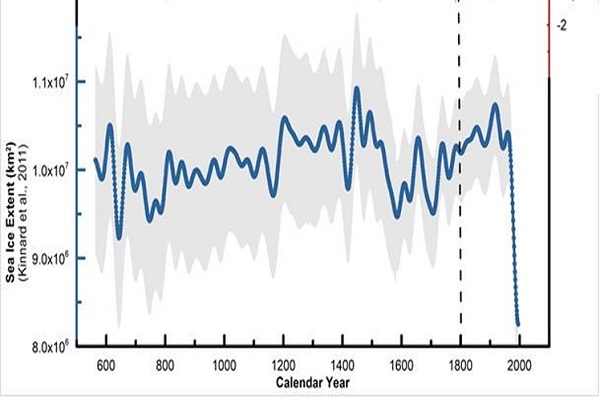
The polar region shows no sign of returning to its reliably frozen state of recent decades, and its permafrost is thawing faster than ever before, the report warned.
‘The Arctic is going through its most unprecedented transition in human history, and we need better observations to understand and predict how these changes will affect everyone, not just the people of the north,’ said Jeremy Mathis, head of NOAA’s Arctic Research Program. ‘The Arctic has traditionally been the refrigerator to the planet, but the door of the refrigerator has been left open.’
Research shows that changes in Arctic sea ice and temperature can alter the jet stream, a major factor in U.S. weather and climate patterns.
‘There are some connections between the warming in the Arctic and the extreme weather events down here,’ Mathis said.
The shift is likely partly responsible for the recent unusual weather in the U.S., including the destructive wildfires in California and the sharp cold snap in the South and East, according to NOAA scientist James Overland.
Another expert, David Aplin of the World Wildlife Fund, who was not involved in the report, added that it is ‘further evidence of the dramatic change occurring in the Arctic ‒ from rapidly warming temperatures to dwindling sea ice to melting permafrost.’
‘The path forward is clear: climate change mitigation is absolutely vital,’ he added. ‘We need to reduce emissions, end our reliance on fossil fuels and embrace a clean energy future ‘ for the good of our planet, its people and wildlife.’
Some of the findings in this year’s report include:
-Warmer air temperature. Average annual air temperature over land was the second-highest after 2016 in the observational record, with a temperature 2.9 degrees Fahrenheit above the average for 1981 to 2010.
-Declining sea ice. This year’s maximum winter sea ice area, measured each March, was the lowest ever observed.
-Above-average ocean temperature. Sea-surface temperatures in August were 7.2 degrees Fahrenheit above the average in the Barents and Chukchi seas.
-Arctic ocean plankton blooms increasing. Springtime melting and retreating sea ice, which allows sunlight to reach the upper layers of the ocean, continues to stimulate increased chlorophyll.
-Greener tundra. Overall vegetation, including plants getting bigger and leafier, and shrubs and trees taking over grassland or tundra, increased across the Arctic in 2015 and 2016.
-Snow cover up in Asia, down in North America. For the 11th year in the past dozen, snow cover in the North American Arctic was below average, with communities experiencing earlier snow melt.
-Less melt on Greenland ice sheet. Melting began early on the Greenland ice sheet this year but slowed during a cooler summer, resulting in below-average melting when compared to the previous nine years.
NOAA began its annual Arctic report in 2006. This year’s peer-reviewed report was compiled by 85 scientists and issued during a briefing at the American Geophysical Union’s annual meeting in New Orleans.
 Escambray ENGLISH EDITION
Escambray ENGLISH EDITION





Escambray reserves the right to publish comments.